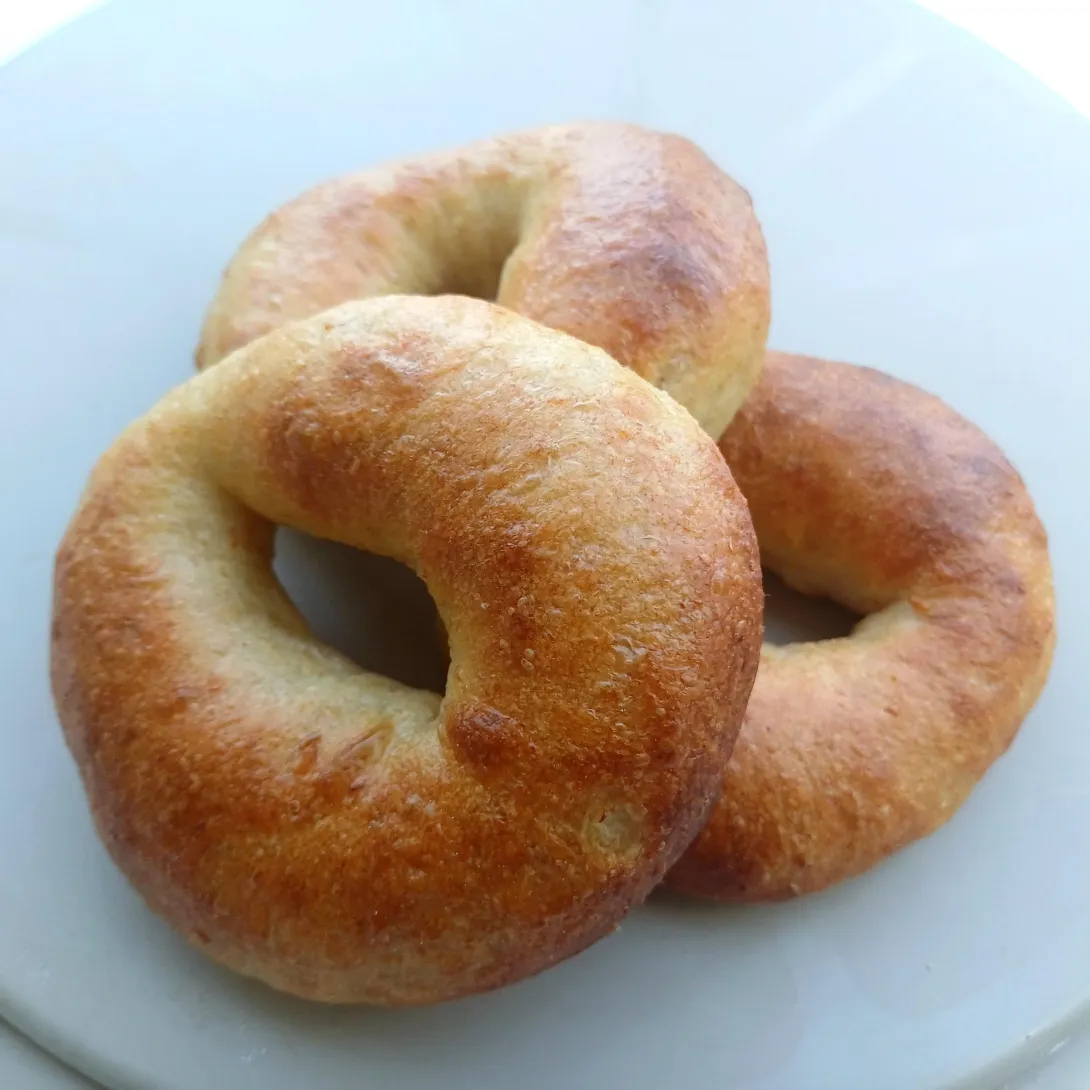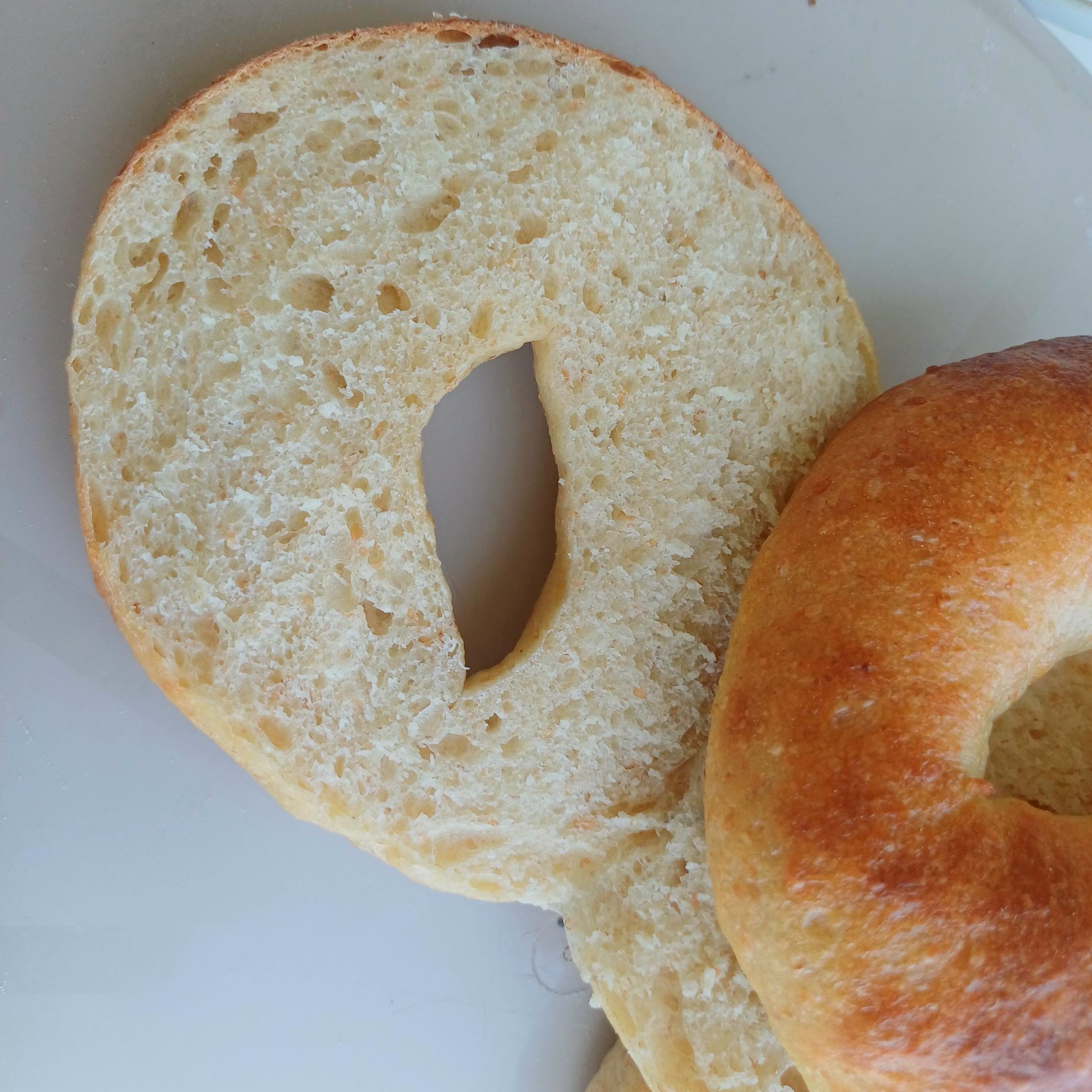
Had a good friend coming over for a run and lunch today, but I was lazy and woke up too late! I don't usually like to make any yeasted product in less than three hours, but today was such a day and I was determined to make the best of it.
20% of the flour was made up of whole einkorn and wholewheat and I made a 1:3 tangzhong out of this. To this I whisked in milk, some olive oil (not conventional, I know), salt, bread flour and IDY to make a dough that felt like 65% hydration. Knowing that bulk fermentation could only be 1.5 hours long - meaning the dough would not double in time; I don't use much yeast - I kneaded this for a while to build some strength.
After 1.5 hours, I shaped them into balls, poked a hole in each, and tightened them into rings. Left to proof for 35 mins, boiled on each side in a sweet bath for 1 min, then baked at 210 degrees for 15 mins. Et voila! Lunch is ready. Pleased with the results. Very wholesome tasting, good rise and soft texture, not overly yeasty, and all in a morning's work.

I had this with smoked salmon, homemade pesto and cream cheese. The running men - 22 km in the forest gave them an appetite for 4 bagels each - had them with bacon. Broccoli soup on the side.
After lots of amateurish bagel making, I've learnt that the best results for me (i.e. mix by hand, minimal work) come from:
- Ensuring at least a double and better still a triple bulk fermentation to build strength; if not possible, do much more upfront kneading.
- Tight shaping is important. For me the hole poking method and tightening seam side down produced the best results.
- It's easy to over proof; ballpark 35-50 mins at RT 25-27 degrees is safe. Expand in volume by about 150% at end of proof; doubling is too much and might result in bagels collapsing when they are out of the boiling water.
- I've used all kinds of sweetening agents for the water bath - I ran out of brown sugar today and used agave syrup and sugar.
- Baking at high temps is crucial for good browning, slight crust and soft interior!
- ll433's Blog
- Log in or register to post comments
Lin, these are excellent. I haven’t tried making bagels yet, but keep meaning to try. Well done getting these results with so little time.
Benny
They look lovely and light, Lin.
Benny, if you're interested in a recipe (from a Cdn site, not that that matters), this is my go-to. Not much yeast in it either. I use bread flour instead of ap.
They were, surely. And they kept well too.
Thank you for sharing that Moe.
Benny
Keep us posted when you do try them! I look forward to some black sesame versions.
nontraditional, but hella nice bagels for sure, Lin.
Do you always do a sweet boil?
Rob
And yes I always do a sweet boil, and I do use the malt if I happen to have it! Thanks for your comment; it made me smile.
Excellent bagels! And they have that traditional bagel look about them too! No malt either!
I wouldn't have thought it was possible to achieve what you did without say doubling the amount of yeast.
And kudos to the "running men" - consuming 4 bagels is quite a feat.
-Jon
When the running men are around, the bread needs to be ready quickly and in copious amounts.
In the past I would have added a lot of yeast to ensure a good speedy rise, but over time I've learnt that it's more reliable to mechanically build the strength if time is really short. As long as 150% rise is ensured during bulk fermentation, we'll be OK. Of course, bagels are also a little more forgiving in this respect.
Nice bagels, Lin! I bet they taste good too. I hesitate on trying to make bagels, since I don't really understand what they supposed to be like. Maybe one day!
I can tell you really love broccoli soup! 😆 I put raw broccoli in my kimchi nowadays
Jay
An important thing to know about bagels is that they aren't what they used to be. So you have to decide if you want to produce one fitting today's expectations (boo!) or one like they were back in the day (yay!).
Today's bagels, at least in the US, are too large and too soft, and taste and feel pretty much like ordinary bread. Bagels in the 1950s and 1960s (my formative years) in large cities that had a lot of bagel manufacturers (especially New York, Chicago) had a chewy crumb and a very thin but tight crust with a smooth sheen. The crust, the way I remember them, didn't crunch or crackle when bitten but held the bagel together when it was bitten into. Despite the firmness and chewiness of the bagel it didn't squish out soft ingredients like lox (salmon) when bitten. There was a subtle maltiness about the taste. The crust was always smooth and did not have little blisters.
TomP
We have more bagel shops, pizzerias and take out Chinese on Long Island than anywhere in the USA. Most of the bagels are still boiled and are pretty darn good. Maybe not quite as good as the Jewish bakeries in Brooklyn or NYC but they are close. I’ve had the sorry excuses for bagels in other parts of the country while traveling and I can only say they were like eating stale rolls with a hole 🫣🙄
You're so observant - broccoli soup is on the menu here once a week. Followed by a close tie between cauliflower soup and leek soup.
I would love to try your broccoli kimchi with cinnamon rolls, please :)
I think bagels mean so many different things for people. For me it's the chewiness, robustness and lingering sweetness that differentiate a bagel from other breads. I first had them in London Brick Lane a decade ago and that's what I have in mind when I think of bagels.
These look delicious! 20% whole grain to boot!
Could certainly up the wholegrain even further! Hope your low-carb diet has been going well for you.
For such a quick bake these are amazing. I have so many good bagel places where I live I rarely make bagels. I need to give a go at some SD bagels with fresh milled flour soon.
Best,
Ian
Appreciate your comments. I'm sure your freshly milled flour will produce excellent bagels! Looking forward to your results and any additional twists you integrate.